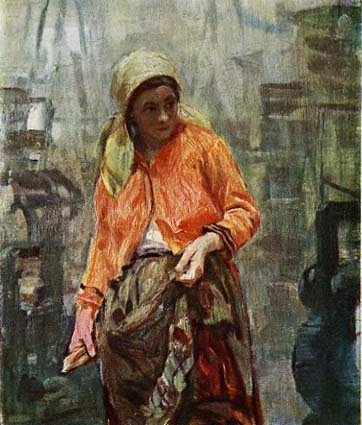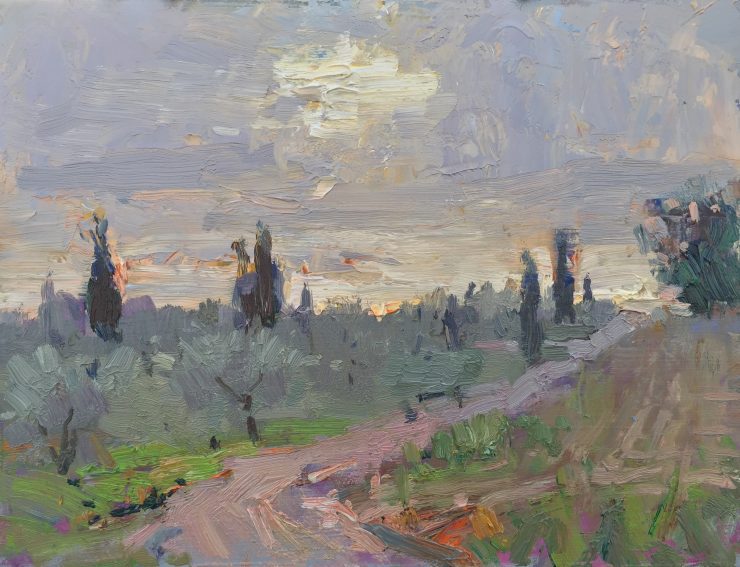(Get free painting tips and plein air painting techniques sent straight to your inbox or on my social media.)
Green is gorgeous and springing up everywhere.
Yes, I actually believe green is one of the most wonderful colors but have you ever wondered what colors make green? I often read that greens are difficult. But maybe this depends on your perspective. From where I sit there are a great variety of them and so making green means you will most likely wonder what colors make green for many of the paintings you will be working on. It’s all about how you see things.
This article will go a long way in your understanding about what colors make green.
Greens in the spring
Spring is a great opportunity to see many vibrant and fresh greens. Greens are everywhere and there is a tremendous variety in different climates and areas. There are very warm greens bordering on yellow and very cold ones that are almost blue. Different seasons and different climate zones can require modulating the cool/warm relationships of the greens in our palettes.
We want to be aware of these changes as especially painting plein air and in different places, or the entire painting can look off. For example, spring greens can be shockingly bright against the muted winter colors often still present. These fading winter tones, usually dull create a backdrop that allows the sparkle of spring greens to stand out for a few weeks.
Greens in the summer
As we approach summer it won’t be long before what is called “The Wall of Green” blankets the landscape, and those bright greens gain depth and warmth, changing our palette again. Painting the greens for a dry, high mountain forest will be a very different palette mix from painting a deciduous forest on the southern seacoast, or the cool blue greens of the tropics.
We hope that you will take time to practice matching greens with your chosen medium. Not only to mix greens from your primary palettes but to experiment by mixing other hues of blues and greens to expand your knowledge and understanding of color mixing and how color works, as well as how to get the effects you want in your work. Eventually you will get hold of the fact that what colors make green.
It is highly recommended that you make and group greens by hue, saturation, and value and record them for reference. Learn which ones are high saturation, and how to make dull or neutralized greens to make the saturated colors in your works stand out.
What colors make green – the history
Let’s look at some historical facts about green and try to understand what colors make green. Egyptians used ground malachite, a naturally-occurring stone. They were one of the first to develop synthetic pigment, Egyptian Blue, mixed with Naples Yellow to make greens. Egyptian blue is a synthetic blue pigment made up of a mixture of silica, lime, copper, and alkali.
Malachite was also used by the Romans, as was verdigris and a new color, green earth, which is a type of clay colored by iron oxide, magnesium, aluminum silicate, or potassium. Large deposits of green earth were discovered in the South of France near Nice, and in Italy around Verona, on Cyprus, and Bohemia. Cobalt green, a translucent pigment sometimes known also as Rinman’s or zinc green, was discovered by a Swedish chemist, Sven Rinman, in 1780.
Green chrome oxide was created by the chemist Pannetier in Paris in 1835.
In the 19th century, emerald green was created by hydrating chrome oxide.In 1927, pthalocyanine dye was accidentally made by Swiss chemists. Which goes to prove that there are happy accidents!
This is an amazing piece by a Russian master. If you look closely you will see green in the clouds as well. He uses both analagous and contrasting color and has a good solid notan structure.
So let’s look for a minute at these example paintings. What do they have in common? And specifically looking at color what do they have in common? They have wonderful color harmony. They have a complimentary color present, (color that is the opposite side of the color wheel) as part of the focal point. They use both vivid and dull or grayed greens to keep interest, and focal points strong.
Why make green if it comes in a tube?
Good question, because part of understanding color is understanding that many tube greens are already a mix of what you have in your palette. Since green is a secondary color it must always be made of yellow and blue. Many artists have chosen not to use tube greens but mix their own.
This can also be a useful way to help the colors in your paintings harmonize. Another reason is to control color harmony. By mixing your greens from the blues and yellows already in your palette you increase the cohesion of color, even when adding the third color to make greyed greens by using what is already present on your palette you keep the sense of a single family of color in your paintings.
What colors make vivid green?
Do you want to know what colors make green? This is your opportunity to play with many kinds of yellows and blues. I suggest you start off with a few standard yellows and blues that should be in the most basic palettes and go from there.
Remember all hues have a bias that make the color lean to the cool or warm side, and many earth pigments although called neutrals also have a warm or cool bias. Here is a link to a paint site that has a helpful chart to see if your hue is warm or cool. Check out color temperature and value list here.
So what colors make green? We will mix cool blues and cool yellows to start. Phthalo blue (green shade), prussian blue, or payne’s grey (its a blue) and hansa yellow, lemon yellow, or cadmium yellow light.
We encourage you to make a system where you can easily look back and see what hues make what greens. If you add a third primary then make note of that addition. One way to do this is to label your chart and make the base greens, then beside the first swatch add the third primary swatch so you can see how the green changes.
Here is an example. Lemon yellow has a cool bias yellow, aureolin yellow has a warm bias. Phthalo blue, (green shade) is cool, as is prussian blue. Ultramarine blue has a warm bias, note the lower saturation in the mix where a cool and warm bias are mixed.

This work by Barry John Raybould is a great example of the use of greens going from warm and saturated greens in the foreground, then cooler grayed greens that move you from the middle ground and into the background. He has used a split secondary color harmony with a vivid primary palette. Read on to find out more about what colors make green.

What colors make dull or grayed green?
Start to understand what colors make green and practice making dull greens using cobalt, ultramarine blue, cerulean, cadmium yellow medium, and ochre. Then add burnt sienna to each of these combinations and see what happens.

You can also try a saturation scale with a red on one side and a green color (opposites on the color wheel) and have them meet in the middle. This will be the most grayed green of that partnership. But try this with a blue and yellow as well to see the full range of greens those two hues can give you. This is an important step towards understanding what colors make green.

Here are some sample greens from my palette. I did not use black, though I hear that black and yellows make some old world greens. Also, on the left side of each swatch is dominant blue and right is dominant yellow. See if you can spot the vivid/high saturation greens and the dull/lower saturation greens. If you can, then you have a good idea about what colors make green.

A great example of dull greens
Color maps by VAA student Adrien
Here are some wonderful examples of color maps featuring green. This is a great way to get some green color mixing practice in. See how far you can push those greens and the saturation to make dull greens as well as mixing cool and warm greens and putting them next to one another to see how they feel.
Notice in a couple of the maps how well he has captured the feeling of warm light from the photo. By now you must have had a fair idea about what colors make green.

What makes green sing?
Now that you have understood what colors make green, let us see how can we make those greens more impressive and eye catching? Notice in the paintings above, there is the presence of the complimentary hue of red present. The more saturated reds are nearest the center of interest in the paintings, and often nearest the most saturated greens.
Placing the combination of the higher saturated hues together in the focal area draws the eye to that part of the painting, while using lower saturation of the complimentary colors throughout the painting in strategic places keeps the eye moving throughout the scene.
Using a split complimentary combination will have a similar effect. Adding spark to what could become a monotonous collage of greens.

In this painting by Kasatkin we see the split complimentary theme of greens, with red-orange and orange. This makes the subject the star, as well as making a nice color harmony within the greens.
Let’s look at another example of greens used with analogous color (using color immediately to the right and left of the main color on the color wheel) to create a totally different mood in the work.
This painting has the highest saturation of greens and blues in the foreground. The yellow and the green highlights become dull less saturated as they recede into the distance.

I hope this article on what colors make green has been helpful. Happy mixing!
#HowToMakeGreen
Thank You
Thank you for taking the time to read this article. I hope you find it useful. If you would like to get free painting tips by email, please sign up for my free tips newsletter.
If you are interested in a structured approach for learning how to paint, take a look at my online painting classes.
Happy painting!
Barry John Raybould
Virtual Art Academy













fabulous
Love mixing greens. Thank you Barry! A very informative article!
So glad you enjoyed this article and found it helpful. 🙂
by Chris Davis the author
Impressive ! Thanks for the post .
Great share
Glad you are enjoying the information here. Happy Painting, 🙂 thanks, from Chris Davis author and artist